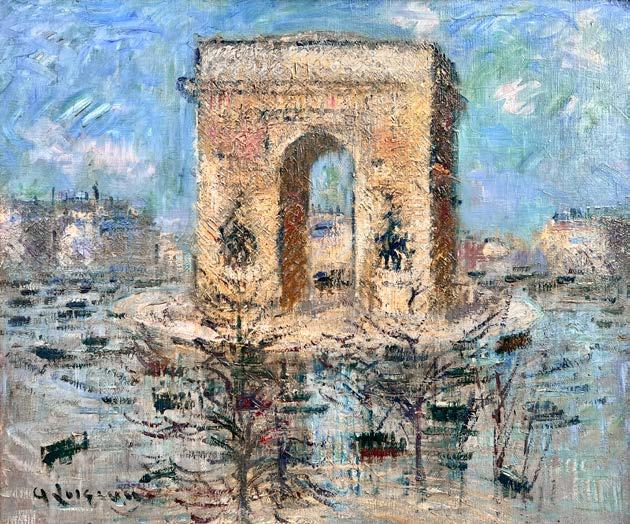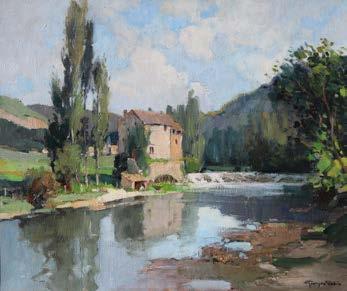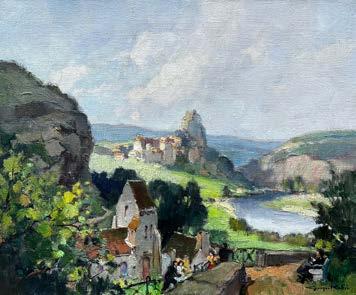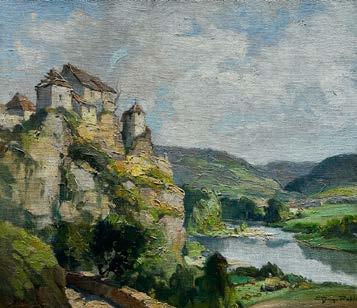
7 minute read
Gustave Loiseau
French, (1865-1935)
A richly atmospheric painting, Rivière en Normandie captures the unique violet light of the late afternoon, delineated through a complex matrix of purple brushstrokes with which Loiseau suffuses the vivid green banks of River Eure.
The Eure, a tributary of the Seine which runs between Normandy and Centre-Val de Loire in north-western France, was a favoured theme to which Loiseau returned on many occasions throughout his artistic career. Only a few kilometres from the River Seine, the area offered a wealth of inspiration for a follower of the Impressionists. Amongst the artist’s favoured river scenes, the Eure dominates Loiseau’s pictorial output to a far greater extent than any other waterway.
As part of his project to capture more complex weather conditions and atmospheres than his Impressionist forebears, Loiseau often returned to his favourite settings multiple times. Loiseau thus painted the Eure in all seasons and at various times throughout the day; veiled by the morning mist, lit by bright sunlight or, as in Rivière en Normandie , in the complex purple light of the early evening. This view of the Eure, so loved by the artist, recalls the work of the Monet and Sisley in its themes and composition, however Loiseau’s technique and innovative brushwork adds a brilliant atmosphere and vibrancy to the composition which is entirely the artist’s own.
The broad expanse of the river in the foreground delights the senses as Loiseau superbly captures the rippling effect of a wind blowing across the surface of the water. This energetic landscape is animated by the movement of the rolling clouds in the sky, painted with longer, looser brushstrokes than their reflections in the water below. Where Loiseau delineates the foreground in straight vertical and horizontal touches, he instead conceives of his clouds as a cluster of circular strokes, suggesting a swirling and eddying movement of wind.
The way Loiseau has captured movement in Rivière en Normandie is outstanding. Swift brushstrokes dance across the canvas to the left, conveying the sway of the tall trees in the background. It seems that Loiseau must have sought to contrast the upper and lower registers of his painting. Where the sweep of foliage on the riverbank is captured in spontaneous, almost brushed strokes, the clouds and tops of the poplars are rendered in larger, more heavily worked patches of colour. Thus, where the foreground of the painting remains still, as the viewer’s gaze progresses up the canvas these larger strokes give an increasing impression of movement.
In around 1913, the artist rapidly began to adopt a much freer pictorial approach, characterised by a looser application of paint and a turn towards increasingly intense pigments. Rivière en Normandie therefore represents one of the first works in a period of great experiment throughout the 1910s, and is one of a small group of paintings that would set the tone for the rest of the artist’s career.
La Place de L’Étoile
3
Painted in circa 1929
Signed ‘G Loiseau’ (lower left)
Oil on Canvas
54.5 x 65 cms / 21½" x 25½"
Gustave Loiseau
French, (1865-1935)
Provenance
The Modern Art Foundation, Geneva, no. 1224.
Sale; Christie’s, London, 27 June 1989, lot 353.
Sale; Christie’s, London, 26 June 1996, lot 150.
Private Collection, USA.
Sale; Christie’s, London, 3 February 2004, lot 160.
Private Collection, Canada.
Sale; Christie’s, London, 24 June 2010, lot 413.
Sale; Sotheby’s, New York, 15 November 2016, lot 107.
Private Collection, Florida, USA.
Gladwell & Patterson, London; acquired from the above in 2022.
Exhibited
Geneva, Petit Palais, Post-Impressionnisme (1880-1910), July – September 1980.
Literature
'Gustave Loiseau', in Style, Vol. II, 1963 (illustrated pp. 80-83).
Journal de l'amateur d'Art, Paris, no. 486, 2 December 1971 (illustrated p. 6).
This work will be included in the forthcoming Catalogue Raisonné being prepared by Didier Imbert.
Gustave Loiseau
French, (1865-1935)
La Place de L’Étoile was painted in 1929, during a period in which Loiseau depicted the Arc de Triomphe from various viewpoints throughout the cold winter months. Painted in the later years of Loiseau’s artistic career, this subtle winter cityscape stands out amongst the artists’ mature œuvre for its distinctive post-impressionist brushwork and exemplifies the unique cross hatching technique for which Loiseau is known.
In the 1920s, Loiseau began to spend increasing time in Paris at the encouragement of Durand-Ruel. While he kept his studio on the Quai du Pothuis in Pontoise, his successes allowed him to open a second studio in the capital on the Quai d’Anjou. Loiseau was thus able to continue to capture the waterways of Northern France in spring and summer, but in the winter his attention turned to the urban environment. Although the artist would initially paint smaller scale works directly from his studio window, by the mid 1920s he would increasingly turn towards larger scale Parisian subjects. Three settings in particular are emblematic of the artist’s work in Paris: the Rue de Clignancourt, the Place de la Bastille, and of course the Place de l’Étoile.
The Place de l’Étoile, now renamed Place Charles de Gaulle after the president’s death in 1970, is the iconic meeting point for twelve avenues which converge on the Napoleon’s Arc de Triomphe as part of Baron Haussmann’s renovation of Paris in the 1860s. Multiple Impressionists would make these new boulevards the subjects of their work, from Caillebotte’s Rainy Day to Pissarro’s views of the Boulevard Montmartre, yet it would be Loiseau who first systematically studied the Place de l’Étoile. These wide streets had been favoured by artists as emblems of modernity since their inception, and Loiseau’s work continues in this vein, providing an early depiction of circulating streetcars on one of Paris’s busiest junctions.
By the late 1920s, when Loiseau painted La Place de l’Étoile , he had already enjoyed considerable success both in Paris and abroad, where he was emerging as one of the few artists that were able to expand and seek new aspects of the Impressionist style. In his quest to create movement and light, Loiseau had developed a distinct style of the ‘cross hatching’ technique, referred to as ‘en treillis’ (latticework), thereby creating the supple and ephemeral quality for which his work is known. In La Place de l’Étoile , Loiseau applied this unique technique to the Arc de Triomphe. A homogeneous and yet vibrating colour structure is created by his staccato-like brushwork, developed from the pointillism of Seurat and Signac.
La Place de l’Étoile , like so many of Loiseau’s best works, represents the synthesis of impressionist subjects and preoccupations with the artist’s own unique pictorial language. Constructed around the monumentality of the Arc de Triomphe, the artist creates a composition which succinctly balances the circular movement of modern traffic with the solidity of the iconic landmark. La Place de l’Étoile thus serves as one of the best encapsulations of Loiseau’s continued experimentation into his late career.
Georges Charles Robin
French, (1903–2002)
Recognised as one of the best, but largely undiscovered, Post-Impressionist artists, Georges Charles Robin’s skill and complete command of his palette set him aside from his contemporaries. Following the en plein air practice of the Impressionist masters, in a few swift brushstrokes Robin brought life to the trees and rivers of the French countryside.
Robin was born in Paris. He studied at École des Beaux-Arts under the master painter Paul Michel Dupuy. Robin went on to become a well-known decorative artist, before securing a job as the scenery artist for the Charleville Theatre and the Dinan Casino.
Robin lived in the affluent suburb of Rueil Malmaison on the western outskirts of Paris throughout his life. The summer months were often spent near Morlaix in Brittany where Robin had a second home; there he would capture idyllic seascapes and charming river estuaries bathed in sunshine. However, throughout Robin’s career the Loire Valley and the Dordogne region inspired his greatest works.
Enthralled by the enchanting river valleys of rural France that flowed through the luxuriant countryside and rolling fields, Robin’s paintings perfectly capture rural French life.
Following the en plein air practice of the Impressionist masters, in a few swift brushstrokes, Robin brought life to the trees and rivers of the French countryside. Robin was a master at capturing the change in temperature and atmosphere. His restrained use of colour allowed him to capture a warm summer’s afternoon or a blanket of snow with profound skill. Combining his deft and delicate touch with vigorous, dramatic brushstrokes and palette knife work, he produced exceptional landscapes. Robin's skill in emphasising nature's basic structure and his sympathetic interpretation using pure colouring only enhances his total control of the medium of oil paint. His love of nature in all her moods inspires a fine sense of permanence in his craft and his treatment of the rustic architecture that exists in many of the towns and villages of France is unrivalled.
Robin was a member of the Salon des Artistes Français, the Salon des Paysagistes Français, and the Society of Arts, Science and Letters. He was an officer of the Académie des Beaux Arts, director of the Institute of “Instruction Publique”, and a former Professor of the Technical High School. He was highly lauded, achieving virtually every major award in French painting for his work, among which the Hors Concors stands out as one of the highest and most esteemed awards of an artist of the time.
Gladwell & Patterson’s history with this distinguished artist began after the Second World War. Herbert Fuller of Gladwell & Company, London, discovered the landscapes of Robin in the Paris Salon in 1948, and approached the artist in his studio. Since he first set eyes on Robin’s landscapes in Paris, Herbert Fuller, and the two subsequent generations of the Fuller family of Gladwell & Patterson have continued to share the legacy of this great artist. The gallery has both an outstanding library of his work and a highly cultivated knowledge of his practice. We are currently preparing a Catalogue Raisonné of his work.
Sur Le Loing, Le Matin, près de Nemours
Oil on Canvas
46 x 55 cms / 18" x 21½"
Provenance
Private Collection, France.
Gladwell & Patterson, London; acquired from the above in 2020.
Exhibited
Exibited at the Paris Salon, after 1948.
Le Moulin de Gazals sur L'Aveyron
Oil on Canvas
44.5 x 53 cms / 17½" x 21"
Provenance
Private Collection, Cholet, France.


Gladwell & Patterson, London; acquired from the above in 2021.
Exhibited
Exibited at the Paris Salon, after 1948.
Oil on Canvas
46 x 53.5 cms cms / 18" x 21"
Georges Charles Robin
French, (1903–2002)
Provenance
Galerie Otto, Vienna.
Gladwell & Co., London (Stock Number 10026); acquired from the above in September 1962.
Private Collection, UK; acquired from the above in November 1962.
Gladwell & Co., London (Stock Number 15641); acquired from the above in December 1987.
Private Collection, Jersey, Channel Islands); acquired from the above in May 1988.
Gladwell & Patterson, London; acquired from the above in 2022.
Vallée du l'Aveyron à Penne - Ruines du Château d'Adelaide de Penne
Oil on Canvas
38 x 46 cms / 15" x 18"
Provenance
Private Collection, France.
Gladwell & Patterson, London; acquired from the above in 2022.
Exhibited
Exibited at the Paris Salon, after 1948.
Calvignac et le Lot

Oil on Canvas
46 x 55 cms / 18" x 21¾"
Provenance
Private Collection, France.

Gladwell & Patterson, London; acquired from the above in 2022.
Exhibited
Exibited at the Paris Salon, after 1948.









